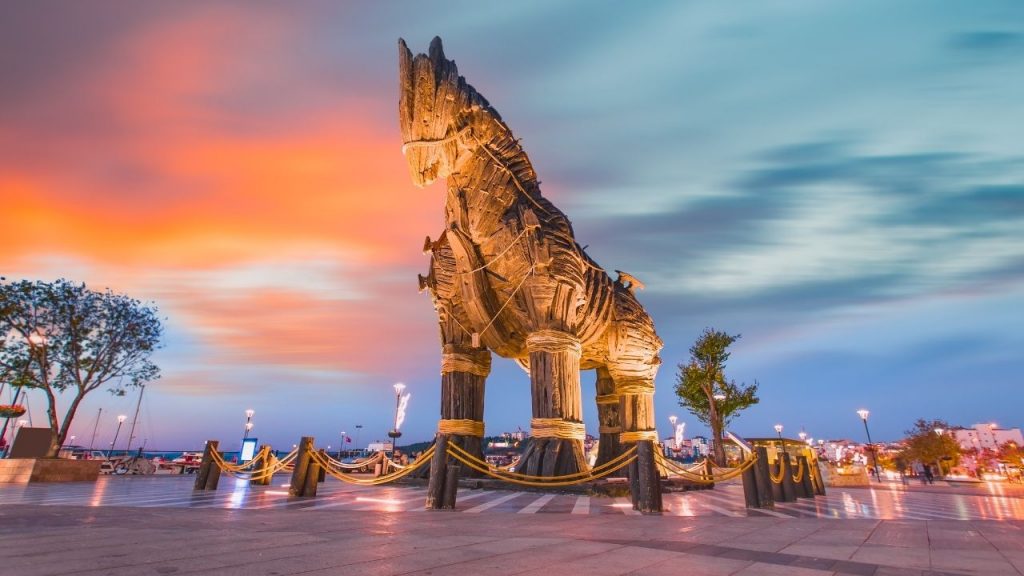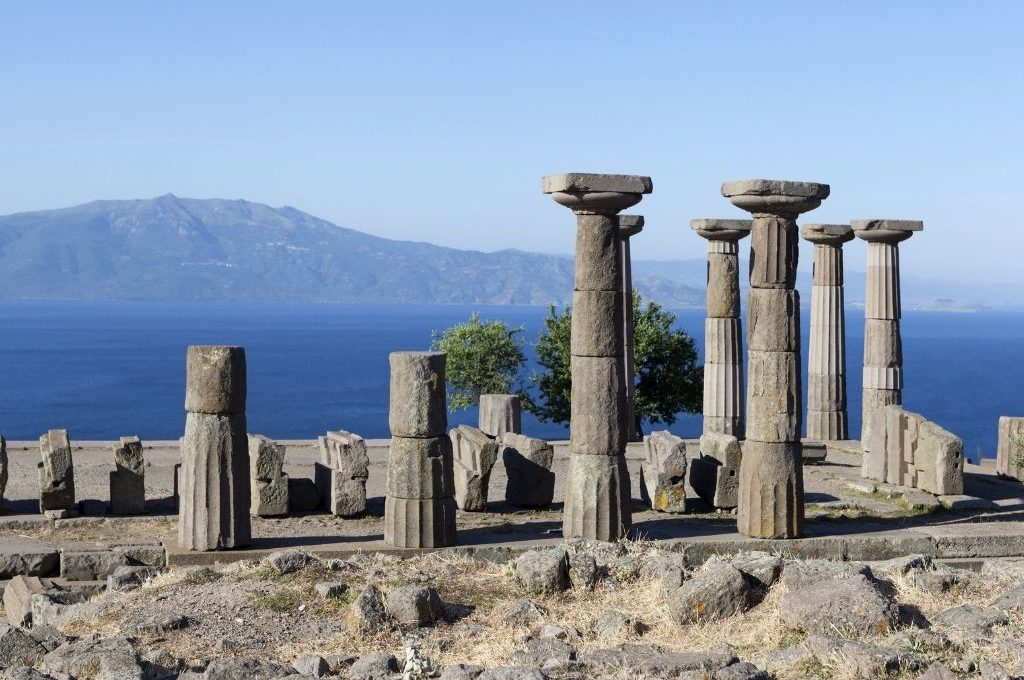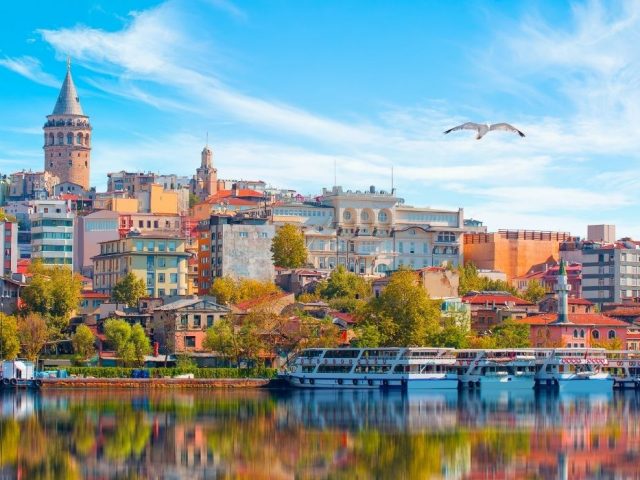“There is only one sea on earth where the sea is like the sea, and that is the Aegean.”
These words belong to Ionian Homer, the author of the epics Iliad and Odyssey. Homer said this sentence for Çanakkale, or Troy, which includes both Marmara and the Aegean.
Troy is thought to have been founded in the 3rd century BC. Even someone who has no interest in mythology has surely heard of the Trojan War. The Trojan War, which took place between the Greeks and the Trojans in the Bronze Age and lasted 10 years, took place in this very land. The region has been excavated by archaeologists for years. As a result of these excavations, you can see the ruins of the ancient city and even the Trojan Horse.
Before starting the article, let’s remind you: Don’t forget to download the Piri Guide mobile app to explore Troy step by step with your personal and digital tour guide!
The Discovery of Troy
The person who brought Troy to its current fame was a German merchant. Although some sources say that the merchant Heinrich Schliemann was an archaeologist, he was not. Schliemann thought that the ancient city was located in Hisarlık Tepe and carried out an unauthorized excavation. His aim was to reach the treasure of Troy and smuggle the archaeological remains abroad, which he did. This excavation site was later protected by UNESCO and declared a historical national park.
Where Does the Name Troy Come From?
We all know about the famous Trojan War or are somehow familiar with the story. But what exactly does the name of this ancient city famous for the Trojan War mean?
Tradition says that it was Prince Ilos of Troy who founded the city of Troy. In Greek, “Troy” or “Troy” means “wall” or “mound” in Ancient Greek. But the real reason why the city was known by this name was Ilos’ father Tros. This was not the only name of the ancient city of Troy. It was also called Ilium and Wilusa in ancient times.
Where is Troy?
Troy is located on the Biga Peninsula within the borders of Çanakkale. The ancient city and museum are located on the western shore of the strait, 70 kilometers southwest of the city.
How to Get to Troy?
You can get to Çanakkale by road or by air. After landing at the terminal or airport, you can take public transportation or a taxi to the city center. You can go to the Ancient City of Troy from the center or you can get off directly in Geyikli and take the minibuses in the area.
Places to Visit in Troy
We’ve made a list of must-visit places in Troy. Yet, we should remind you that you can find more on the Piri Guide mobile app. Piri Guide detects your location, offers you the best travel routes, and starts telling you the hidden stories of wherever you are. All you have to do is to get your headphones or earbuds and follow the path at your own pace. Then, don’t set out for your trip before downloading the digital travel guide!
The Trojan Horse

The first great battle of East and West was Troy. In the war, Achilles represented the West and Hector represented the East. When Achilles killed Hector, Hector’s brother Paris killed Achilles.
The Trojans and Thracians fought hard not to lose the Dardanelles to the Achaeans. The turning point was the Trojan Horse, the brainchild of Odysseus, the daredevil soldier of the Achaeans. The authenticity of this horse is still debated, but there is no denying that it is one of the most important war tactics in world history. The Trojans initially mistook this wooden horse for a gift from the god Athena and allowed it to enter the city. However, when the Achaeans hiding inside attacked, the city fell. Thus, the war ended.
There are two Trojan Horses in total; one in the center of Çanakkale and the other in the ancient city. However, the Trojan Horse model you will see in the center of Çanakkale is different from the horse exhibited in the ancient city of Troy. The Trojan Horse model you will see in the center was sent to Çanakkale as a gift after the movie Troy.
Troy Museum

Troy Museum is located right at the entrance of the ancient city of Troy. It is a museum where the most valuable pieces from the Trojan War are exhibited. In the niches on the walls of the ramp you will pass on your way to the site, the layers of Troy are explained with tombstones, large-sized sculptures, scene reenactments and large-sized photographs. In the museum, the finds from the excavations carried out in the Troad region are presented to the travelers in an interactive way. When you visit the museum, be sure to take a look at the Troy gold section, Roman sculptures and the Sarcophagus of Polyxena.
Arkeo-Village Tevfikiye
Tevfikiye is a small village between Küçük Menderes and Dümrek streams, right next to Troy. It was founded in 1891. It was named after Abdülhamid II’s nephew, Prince Ibrahim Tevfik Efendi. Abdülhamid took Tevfik Efendi, who was orphaned at the age of 2, and raised him himself. He loved Tevfik Efendi so much that he named a few other places after him.
Tevfikiye Village was named “Arkeo-village” as part of the project. You may be hearing this name for the first time, so let us explain. The aim of the archeo-village is to bring the old texture to the forefront, to give the villagers a historical awareness and to breathe the historical air to travelers like us who come to the village. Therefore, we recommend you to visit Tevfikiye while you are in Troy. You can also buy organic fruits and vegetables here, and you can choose a souvenir for your loved ones or yourself.
Tevfikiye Culture and Art Center
Tevfikiye Culture and Art Center is now a local history museum. There is a meeting area and a multi-purpose hall on the upper floor. On the ground floor, local items and photographs are exhibited. All of these items you will see inside are organized thematically.
Tevfikiye Culture and Art Center takes you to a relatively recent history. You understand this even before you enter the center. You will see two statues outside the building. One of them is Fatih Sultan Mehmet and the other is Mustafa Kemal Atatürk. These sculptures were created by artist Seyhan Boztepe. Boztepe defines Mehmet the Conqueror and Atatürk as two Anatolian heroes who have a connection with Troy. There is even a saying that Mehmet the Conqueror said “I avenged Hector!” after conquering Istanbul. Atatürk had a similar statement at the Çanakkale Victory.
Troy House
These houses, which emerged in the Aegean around 3,000 BC, were called megarons. The architecture of these Trojan houses was an indication of the birth of architecture in Anatolia along with Mesopotamia. In fact, megarons were considered to be the first structures of architecture. This house you will see in the region was in a dilapidated state, but then it was organized and became an example of a Trojan house. In the garden of the house, there is even a special corner consisting of plants mentioned in the Iliad epic.
Those who say “I won’t go without a Çanakkale tour!” can also read our Çanakkale travel guide!





